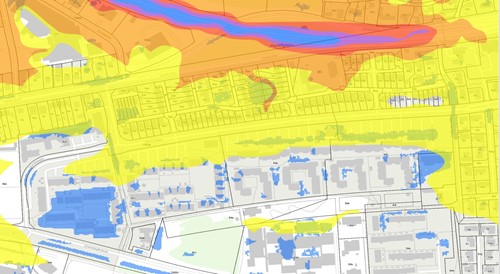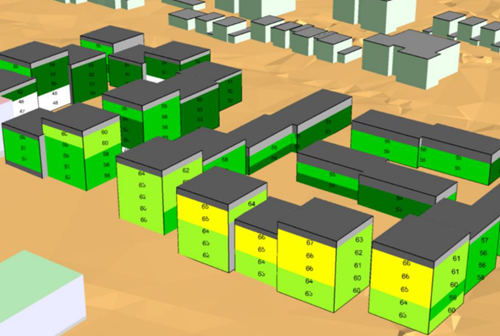Insight
Site resilience rhymes with due diligence

"Blue spot" -analysis. Expected distribution of surface water in an extreme 100 mm rainwater scenario.
Insight
"Blue spot" -analysis. Expected distribution of surface water in an extreme 100 mm rainwater scenario.

More and more property developers and investors are asking for site resilience analyses in connection with property transactions. Such an analysis affords insight into the site’s risk profile with regards to climate change and natural disasters.
Floods, smells, noisy neighbours. On the home front we want to avoid these. But what do developers and investors think when they see a potential development site? Is location the only parameter? No, it is not.
Due to climate change and enhanced awareness of sustainable agendas we can see that long-term perspectives are becoming predominant in the world of property transaction and project development. It is no longer enough to focus on a specific building’s quality, functionality and investment profile from a life-cycle costs viewpoint. Property developers and investors are increasingly looking towards how external factors will affect the property and its planned use in the long term. After all, a stable, long-term income forms the basis for a property’s value.
There is a clear trend and a growing demand towards Site Resilience analyses in connection with a property transaction. Resilience is an expression for the extent to which a site is “immune” to the negative effects exerted by external factors, both now and in the future.
Many investors talk about carrying out an initial screening of the site in alignment with their ESG tools (Environmental, Social, Governance) before initiating negotiations. These ESG parameters ensure that a transaction takes place based on a number of ethic and sustainable guidelines. These guidelines are in place to enhance awareness on the relationship between users, the environment and the local community.
The demand for site resilience analyses is on the increase as a meaningful contribution to an ESG review. At NIRAS, we undertake many property due diligence investigations for clients in connection with property transactions and we can see that performing a Site Resilience analysis is a natural extension to our DD services. To put it another way: Site Resilience rhymes with Due Diligence.
At NIRAS we use a GIS-based information platform (Geographic Information System) that automatically retrieves data from public and private sources. On top of this we add supplementary information from NIRAS’s own data analyses.
We combine all this data from various sources into one data platform, enabling a very effective and coordinated data management system. New data from new sources can be added as additional layers, enabling quick and reliable information to be made available for the area under investigation.

Combined mapping of rainwater and noise exposure as well as cadastral conditions.
There are a number of risks that have to be investigated, depending on the site’s future intended use. However, natural catastrophes are increasingly close to hand. Forest fires, droughts, hurricanes and earthquakes are seldom seen in Denmark, but flash flooding and sea storms arrive on our shores and at our doorsteps at regular intervals. And in the future they will appear more often. A storm that we would be classified as a 100-year storm today will be classified as a 25-year storm a hundred years from now.
When we investigate flash flooding we look at possible scenarios: what will happen if the rainwater system is blocked or has inadequate capacity? By how much does the water level in local lakes and waterways rise under 10-year, 20-year, 50-year and 100-year events? Such an analysis considers the area’s topography, typology and geology. Similarly, for sea storm events we calculate water levels depending on storm strength and wind direction.
In this way investors and developers get a clear picture of the site’s risk profile, enabling the capitalization of various mitigation measures.
A number of other factors can be included in a site resilience analysis, such as:
All the above can be investigated to give the developer/investor a clear picture of how “robust” the site is.

Noise exposure on the facades from train traffic.
